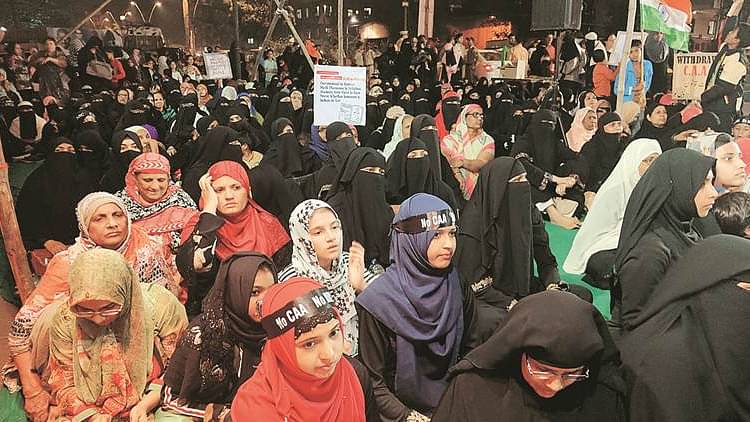It’s been a year since hundreds of women gathered on the street at Shaheen Bagh to oppose the Citizenship Amendment Act, National Register of Citizen (NRC) and National Population Register (NPR) following the attack on students of Jamia Millia Islamia by Delhi Police. These women, both young and old, camped outside in Delhi’s freezing winter for more than 100 days to protest against the laws which would have made religion the basis for acquiring Indian citizenship.
These laws worried Muslims more than the others, because they blocked citizenship through naturalisation for Muslims, while allowing for Hindus, Sikhs and Jains from neighbouring communities to claim citizenship. No one could have foreseen that Muslim women would be at the forefront resisting these laws.
Eighty-two-year-old Bilkis Bano, who became the face of the Shaheen Bagh movement, was named by TIME magazine as one of the influential people of 2020 along with Prime Minister Narendra Modi.
The country had not seen protests of this scale fighting for the idea of India in a very long time. The idea promised by the Constitution that all religions are equal before the State and no religion would be given preference. The protests were an anti-thesis to BJP’s divisive politics. BJP had portrayed them Muslim women as ‘weak’ while enacting the Triple Talaq law. Contrary to this portrayal, the strength of the Shaheen
Bagh women motivated thousands of citizens around the country to raise their voice against these laws.
There was no particular leader in sight, but images of a crowd of women with their children sitting patiently in solidarity and listening with hope were telling. The mothers were fighting for the future of their children. It was to prevent the ‘othering’ of their children when they would not be around. When women who were considered weak and unable to voice their opinions, according to the BJP, sat together, it became difficult for the ruling party to arrest them or give the movement a spin.
Between December and March 2020, the government did all it could to demonise the protests, attack the protestors and shame them for bringing children to the protest sites. The government even condemned the food they ate.
The government, spooked by the rising voices, booked many participants in cases related to the alleged ‘conspiracy’ that led to communal violence in northeast Delhi in February. The government claimed that these activists ‘planned’ the riots during these protests.
By May 2020, several of the students and activists who spoke at these protests were arrested as they were slapped with cases under the Unlawful Activities (Prevention) Act (UAPA). So, Natasha Narwal, Gulfisha Khatoon, Devangana Kalita, Ishrat Jahan and a pregnant Safoora Zargar were jailed simply for exercising their right to protest peacefully.
“BJP was definitely rattled by it, that’s why several of those who participated were targeted. When PM Modi imposed the countrywide lockdown on March 24, the government engaged painters to paint over street signs near Jamia Islamia University and Shaheen Bagh. They wanted to get rid of the artwork. A government which is threatened by art
on a public wall is a government which is insecure,” said Ziya Us Salam, journalist and author of ‘Shaheen Bagh: From a Protest to a Movement’.
In Uttar Pradesh, the Yogi Adityanath-led government openly targeted women who participated in the protests. The idea was to kill dissent. Brutally.
“The Yogi Adityanath government has become even more belligerent and cruel. It has devised a strategy of crushing dissent. They are simply beating up and jailing Opposition party members and activists. After December 19, 2019, when we were arrested, he tried to name and shame us by putting up our personal details on hoardings. He also hit on us economically. He made sure that we were thrown out of the organisations where we were working,” said Sadaf Jafar, a Congress worker and social activist who was jailed by the Uttar Pradesh government for allegedly participating in anti-CAA protests.
Yogi Adityanath has, since then, deployed police to guard Lucknow’s Ghanta Ghar, where the women protested. “The protest affected their psyche and they have not learnt any lessons. But Shaheen Bagh changed the nature of protests in the country. Several protests which came afterwards have been inspired by these women. Just like how there was cultural influx at Shaheen Bagh, the farmers’ protest also has it. The idea of Gandhian protests has returned,” underscored Jafar.
Ajay Gudavarthy, associate professor at the Centre for Political Studies, Jawaharlal Nehru University, is of the opinion that the protests did not have an impact on the larger Hindu population. “Shaheen Bagh was a legitimate movement in terms of the demands that were made. In the beginning, women from all the communities participated, but the larger Hindu community did not participate in anti-CAA protests. That’s
precisely what the BJP wants – to single out Muslims and those standing with Muslims,” said Gudavarthy.
However, Salam pointed out that it was not only a Muslim women’s protest. “It was led by Muslim women, but women from other communities also participated. It was for the first time that women of any community came out to uphold the Constitution of India. Most protests have been led and populated by men. This was one protest where women reminded the government of India of its responsibility towards the Constitution of the country. Muslims did not lead protests against the Triple Talaq law but on the subject of citizenship,” observed Salam.
“I don’t see the Shaheen Bagh as a successful movement. It was well-intended, but it did not make any effort to reach out across religions. This is a problem with how Muslim politics plays out in the country. The country has become more complex and these boundaries need to be broken. It can be explained citing the example of Asaduddin Owaisi. He highlights secularism and social justice, but only to consolidate Muslim votes. This is precisely how BJP is using Owaisi,” said Gudavarthy.
Movements have to realise, contended Gudavarthy, that it’s not the India of the 1950s or 1960s. “Farmers protest has done it. They spoke about political prisoners. Why didn’t Shaheen Bagh protestors do that? Why does Owaisi not join the farmers’ movement or the right to education protests. There must be a legitimate reason given for an average Hindu to support Shaheen Bagh,” he said.
A year on, the rules under CAA have not been notified, so it has not been implemented. Parliamentary guidelines state that once an Act has been passed, rules on how it would be implemented must be published within six months.
While it may seem that the anti-CAA protests have died down, that is not quite the case in Assam or West Bengal. This puts the BJP in a quandary as both the states go to elections in 2021. In Assam, agitations demanding the repeal of CAA have begun. In West Bengal, BJP president JP Nadda asserted that CAA would be implemented because people in the border districts of West Bengal believe that the law would help them as there are many refugees there.
“I don’t think the protest fizzled out. It served its purpose as the women were hugely successful in their task. One year and six days after the Parliament passed the CAA, a notification has not been issued by the Home Ministry for its implementation. The government will not shout from rooftops about its failure. But the women of Shaheen Bagh made their point forcefully and peacefully. Not just in India, but across the world,” added Salam.


























































































